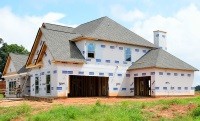
Every investment should be considered from a risk/reward perspective. Ideally of course you want minimum risk and maximum reward. From that perspective I think loans secured by real estate are one of the best investments out there at the moment. A few days ago I discussed Peer Street and Patch of Land, two companies that offer crowdfunding “hard money” investments which are indirectly secured by real estate loans. In that earlier post I explained my reasons for building a portfolio of these investments. The main appeal is the fact that the collateral—real estate—is theoretically worth more than the amount of the underlying loan, so a sponsor like Patch of Land or PeerStreet can sell the collateral to recoup your investment if necessary. Obviously, that only works if someone is willing to buy the underlying property for a price equal to, or more than, your investment amount.
…we’re looking for underlying real estate that could be sold for enough money to recoup our investment if it’s necessary to foreclose.
In a future post I’ll explain how to do a seat of the pants appraisal to verify the property value. It’s important to do your own estimate, because the values assigned by PeerStreet and Patch of Land are sometimes overly optimistic. That could mean the property can’t be sold for enough money to return your investment. But before we get to that, here are four preliminary criteria I use to quickly decide if a loan is even worth that effort. Remember, we’re looking for underlying real estate that could be sold for enough money to recoup our investment if it’s necessary to foreclose:
1. The underlying property’s planned selling price must be within the limits of a “conforming” loan. Most home buyers finance their home purchases with mortgages. Most of the banks or credit unions who originate those mortgages are insured by the Federal government through the FHA, Fannie Mae, or Freddie Mac. All of these organizations have the same top end limits on the loan amount they will insure. Currently those “conforming” limits are $417,000 in most places, up to $625,500 in areas where home prices are significantly higher than the national average. Real estate priced at or below those limits usually sells faster, because home mortgages to purchase them are widely available and relatively easy to get, with fairly low down payments. Fewer home buyers can qualify for non-conforming loans, and fewer still can pay all cash. So if a hard money loan investment is secured by a property worth more than the conforming loan limits, usually you should not invest.
2. The property must be in a major Metropolitan Statistical Area, or “MSA”. This is a term used by the U.S. Census Bureau to describe a geographical region with a densely located population of at least 50,000 people and close social and economic ties throughout the region. While 50,000 is the low end of the MSA spectrum for the Census Bureau, I only invest within MSA’s that are at least two to three times that size. This is because real estate sells faster when there are more people around to buy it. If a deal goes south, I want my money back as soon as possible, but rural real estate can sit on the market for years. While the Census Bureau publishes lists and maps of MSA’s, I find the fastest way to check is to locate the subject property on the satellite view (they call it “earth”) at Google Maps. Enter the property address in the search bar there and zoom to the view that shows 1 mile on the scale at the lower right. If your computer screen is mostly filled with streets and roofs, chances are there are plenty of potential home buyers in the area. On the other hand, if you see mostly Mother Nature, you should probably not invest. Leave this page open at Google Maps for the next step.
3. The property must have reasonably good curb appeal. Most people won’t buy an ugly house. It doesn’t have to be gorgeous, but it should at least match the other houses in the same neighborhood. Don’t judge a property based on your own taste. You don’t have to live there. You just want to make sure there are plenty of other people who would like to live there. To decide, start with a common sense reaction to the photos of the property on the investment page at PeerStreet or Patch of Land. Google the street address to find old real estate listings for the property and drill down into the photos on those pages, too. Finally, to see the property in comparison to others in the neighborhood, go back to the property’s address at Google Maps and this time zoom into “street view.” Move the view up and down the block. How does the subject property compare to the neighboring houses? It doesn’t have to be the nicest looking house on the block, but it should at least be average. Sometimes this process takes imagination, because the underlying loan is for a “fix and flip” investment, which by definition means the underlying property needs work. In those cases, you’ll have to try to visualize how the property would look with fresh paint, a new roof, and so forth.
4. The property must be in a state with a reasonably fast foreclosure process. Due to differing legal processes and the local volume of foreclosures, the process of gaining possession of real estate collateral after a borrower defaults can take as little as nine months (Alabama) to as long as three years (Hawaii, Oregon). You can view a table of the time frames at Fannie Mae’s website. Note that the times shown there are maximums. The average foreclosure time will be less, and in some states such as Texas, much less. I don’t invest in loans secured by properties in states where the maximum foreclosure time is 18 months or longer. You may want to set your limit higher or lower, but once the monthly payments stop on your investment, you’ll want your money back as soon as possible so it’s important to be aware of the worst case scenario where the investment is located.
There are very few perfect deals, so you’ll have to compromise on these criteria from time to time. For example, I recently lent against a condo in Provincetown, MA, even though that’s not in a major MSA (it’s a couple of hours outside of Boston). Why did I break my MSA rule? The condo is directly on the beach, so the “curb appeal” is beyond fantastic. And since Massachusetts has a reasonably fast maximum foreclosure time (15 months), and the exit price is within conforming limits, I think it’s a good investment. The risk/reward calculation is a personal decision. But with a clear investment profile based on the common sense criteria described here, at least you can make educated bets.
For more on this subject, click here and here.
I received no consideration of any kind from Peer Street or Patch of Land for this blog post.
See disclaimer at bottom of page.


